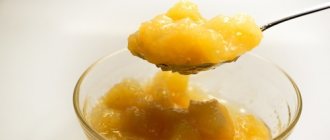Breast milk is irreplaceable, but gradually the child must be introduced to adult food. It develops chewing reflexes, improves the production of enzymes in the stomach and saturates the body with vitamins necessary for development. When the baby is artificially fed, doctors allow complementary feeding to be offered to a 5-month-old child. It is recommended for infants at this age with poor weight gain, persistent constipation and lack of mother's milk.
In order not to injure the delicate stomach, new food should be introduced carefully, little by little, and carefully monitor how the baby reacts to it.
At what age should new foods be introduced?
At how many months should complementary foods be introduced?
- If the baby is on breastfeeding, is healthy, develops correctly and feels great, then the first new products are introduced at 6-7 months.
- It is recommended that formula-fed babies be fed at five months.
- If the baby lags behind in weight gain, then complementary feeding should begin at 4-5 months.
- Breastfed babies are introduced to new foods at five months in cases where the mother's milk is not fatty enough.
The menu of a 5-month-old toddler should include both breast milk or an adapted formula, and complementary foods.
The amount of food consumed per day should be about 1 kg. It is recommended to eat food five times a day at intervals of 3-3.5 hours.
Vegetable purees are suitable for complementary feeding at 5 months, and the child eats them with pleasure
How do you know when your baby is ready for complementary feeding?
It is worth remembering that the recommended age of six months for starting complementary feeding is quite arbitrary. After all, each baby develops at its own individual pace, and the same applies to internal organs. Therefore, you can focus on such signs to understand whether the child is ready for new food.
- His weight has doubled since birth. If we are talking about premature babies, then 2.5 times.
- The ejection reflex has disappeared. Reflexive movements of the child's tongue help protect him from random objects that fall into his mouth. If you give food too early, the little one simply won’t be able to take it from the spoon.
- The baby sits confidently.
- He may turn away from the spoon, showing his reluctance to eat at the moment.
- The little one doesn't eat enough of his usual food. He asks for more formula than normal, sucks mother's milk from both breasts, cries because he remains hungry.
- The first teeth have erupted.
- The baby shows interest in adult food, tries to steal a piece from the parent's plate and try it.
Of course, you shouldn't expect all the signs at the same time. It is difficult to say at what time the baby will learn this or that. He can sit at 8 months, and the first tooth can erupt by the age of one year. This does not mean that complementary feeding should be postponed. It is necessary to look at overall development.
Is complementary feeding necessary at this age?
High-quality formulas contain all the microelements that are required for the full development of children. However, over time, the components available in baby food become insufficient for the growing body, and then useful substances must be introduced in the form of complementary foods. Porridges and purees help compensate for the lack of iron, calcium and other microelements, so that the baby’s body can fully grow and develop.
Formula-fed babies should begin introducing complementary foods at the age of 5 months. The exception is for babies who have developmental problems. In this case, complementary foods are introduced already at four months of age.
Natural food is necessary for babies for the following reasons:
- Essential nutrients help strengthen the musculoskeletal system and promote active growth.
- Children should get used to eating thick food, which, moreover, contributes to the formation of correct taste preferences.
- Complementary foods help the child gradually transition to a new diet.
- If the baby suffers from diarrhea or constipation, then natural food will help normalize stool.
- By eating solid foods, babies acquire chewing skills.
Where to start complementary feeding?
The scheme for introducing the baby to adult food must be agreed upon with the pediatrician. The doctor must examine the baby, evaluate his development indicators and explain to the mother where to start feeding the baby at 5 months.
You need to start introducing new foods with cereals, vegetable and fruit purees, dairy products, and non-concentrated green apple compotes.
To clarify the timing of the introduction of new products, you can use the complementary feeding table for babies up to one year old, which was approved by WHO pediatricians.
This table is not a rigid norm, but a recommendation from leading experts.
Approximate daily feeding schedule for 5-month-old babies:
Over time, each mother develops her own regimen for introducing complementary foods.
Feeding vegetable puree
First of all, you should remember that new foods cannot be given to the baby within 7 days after vaccination.
- The first introduction of vegetables is best done with the help of children's one-component homogenized purees, since in the first days the baby requires a minimal amount of a new product.
- The baby is given one teaspoon of warmed puree before feeding the mixture. If the baby refuses to eat a new product, then there is no need to insist - try again the next day.
- During the day, observe your toddler’s body’s reaction to a new product. If a skin rash appears, it is better to exclude it from the diet for a week, and then you can try giving it again.
- If the introduction of the first product was successful, then after two weeks offer the baby another. It can be given either separately or in combination with the first vegetable already tried.
- Start giving each new product in a minimal amount, and gradually increase the dose every day.
What vegetables are best for feeding a baby? These can be zucchini, cabbage (except for white cabbage), carrots, potatoes, pumpkin, celery. Beetroot has a laxative effect, so it is recommended to give it only in cases where the baby is prone to constipation.
Introduction of cereals
It is recommended to start complementary feeding with cereals at 5 months if the baby is not gaining weight well. It is advisable to cook porridge yourself, using water and without sugar. If your toddler refuses to eat unsweetened porridge, you can use fruit puree as a sweetener.
The first grains a baby is introduced to should not contain protein or gluten, as these substances can cause tummy pain. The best options for a baby's first porridge at 5 months of age are corn, rice and buckwheat. It is better not to give semolina and oatmeal for now.
Cow's milk contains amylase, which the child's body cannot break down due to the lack of the necessary enzymes. Each individual child should be given cow's milk based on the individual characteristics of his body. If the mother wants to introduce this product to the baby, then it is necessary to consult with the local pediatrician, who will explain at what months this milk can be given.
The benefits of timely introduction of first complementary foods
There is a lot of controversy about how many months during breastfeeding to give the first complementary foods. Each baby needs adult food in its own time. Mother's milk contains all the necessary microelements, but in some cases the baby may not be full and require food ahead of schedule. On average, the period of introduction of complementary foods is allowed from the beginning of the 5th month to six months of age. The benefits of new food for children are:
- replenishing the lack of vitamins and nutrients that contribute to the timely and proper development of the baby;
- normalization of the gastrointestinal tract. Fiber contained in vegetables helps solve problems with stool and digestion;
- development of chewing skills, training the muscles of the baby’s upper and lower jaw.
Fruit puree
Complementary food for toddlers, both breastfed and bottle-fed, includes fruits and juices. Pediatricians advise starting to give a green apple as early as four months, since it does not cause allergic reactions.
Applesauce can be purchased as special baby food or prepared independently using the following recipe:
- Wash and peel the green apple, remove the core and place the peeled slices in a small bowl.
- Then you should place the apple in the microwave for 4-6 minutes.
- Grind the baked slices to a puree using a blender or fork.
Applesauce is also prepared using another recipe:
- Remove the core from the apple.
- Then bake it in the oven or microwave, cool and feed the baby, scooping out the pulp with a teaspoon.
After the little one gets used to the apple, move on to other fruits: banana, pear, plum, apricot. You can make juices and compotes from the same fruits. Raisins are great for making the latter. Citrus fruits tend to cause allergies, so they must be given very carefully.
It is up to the mother to decide which purees to give to her child - homogenized or prepared with her own hands. The main thing is to choose only fresh and high-quality products so as not to harm the health of the baby.
What are the options?
Dairy products
If, as Dr. Komarovsky advises, you decide to start with fermented milk products:
- it is necessary to give fresh kefir without sweetening it;
- first serving 1-2 teaspoons;
- gradually increase the mass to 100-150g;
- the structure of kefir must be absolutely homogeneous;
- a week after introducing kefir, you can start giving cottage cheese, adding 1 teaspoon to kefir and stirring thoroughly until completely homogeneous;
- the portion of cottage cheese gradually increases over the course of a month to 30g;
- After a month you can start feeding them porridge.
Porridge
For a five-month-old baby on artificial feeding, it is better to start expanding the diet with cereals.
- The table for introducing the first complementary foods of the World Health Organization (WHO) advises preparing the first porridges from rice, buckwheat, oatmeal or corn cereals, thoroughly crushed in a coffee grinder or blender.
- The porridge should be liquid and warm.
- Don't add sugar.
- It is better to immediately give the baby the opportunity to get used to eating porridge from a spoon (sterile and warm, preferably from an individual children's set of dishes.)
- Start getting acquainted with porridge with 1-2 teaspoons, gradually increasing the portion.
- Unlike kefir with cottage cheese and vegetable purees, porridge is best given before bedtime. According to Dr. Komarovsky, they will help saturate the child well, and he will sleep peacefully until the morning.
Vegetable purees
Many mothers decide to start diversifying their baby’s menu with vegetable purees. The WHO table almost unanimously does not recommend introducing vegetables during artificial and natural feeding up to 6 months into the diet of children who are fed breast milk. But breastfed babies, by the age of 5 months, already need additional products that will provide an actively growing and developing child with important microelements and vitamins.
The table of the order of introducing vegetables into the children's diet will help you decide on the first vegetable for your baby. In any case, it should be a green or white vegetable, neutral in taste, and not causing allergies. As a rule, this is zucchini or cauliflower. Once you have made your decision, follow these rules:
- to prepare puree, choose only fresh and ripe vegetables; wash them thoroughly and peel them;
- It’s better to cook vegetables in a double boiler; you can bake or boil them by putting them in boiling water;
- after grinding in a blender, the puree must be ground through a fine sieve to destroy all fibers and lumps;
- achieve a semi-liquid consistency by adding your breast milk or vegetable broth to the vegetable mass;
- It is recommended to add olive or corn vegetable oil drop by drop into pureed vegetables, gradually increasing its amount to 1 teaspoon;
- absolutely no salt;
- always feed your baby fresh and warm puree, but not hot;
- supplement your diet with a new vegetable only after you have completely gotten used to the previous one.
Fruit purees
Many grandmothers insist that the first complementary foods be in the form of fruit juices and purees. However, Dr. Komarovsky and most WHO experts are convinced that fruits are extremely undesirable for infants under 8 months of age. After all, all fruit complementary foods must be given raw, and the stomach and intestines of a baby who is currently receiving only mother’s milk or is bottle-fed is not yet completely ready to absorb and process such food. Therefore, start additional feeding with cereals, kefir and pureed vegetables. They will prepare small organisms for painless assimilation of fruits in any form.
Introduction tables
What changes in the functioning of the child’s gastrointestinal system?
As soon as the baby’s feeding is supplemented with the first complementary foods, the baby’s liver function is activated and new enzymes begin to be produced. And this immediately manifests itself in a change in the stool: greenery and mucus may be observed in it. If at the same time the child feels normal (calm, positive, he is not bothered by bloating or colic), then there is no need to worry. The stool will definitely return to normal within 5-7 days. You should not be alarmed if the first purees come out without being digested by the body. This is an absolutely natural process of the intestines getting used to innovations.
Remember that the fiber in vegetables tends to loosen stools, while some fruits strengthen them.
Each child's body is individual. Therefore, when deciding that it is time for your baby to receive additional feeding:
- be sure to consult your doctor;
- carefully observe the child’s mood and behavior;
- study the tables on the order of introducing various foods into the diet of infants;
- listen to the recommendations of leading pediatricians, including Komarovsky;
- be patient: if the baby does not immediately accept a certain product, try again and again or return to it in 1-2 weeks;
- Immediately avoid foods that provoke allergic reactions.











